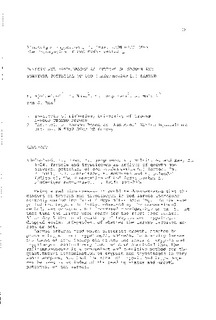Trypsin and trypsinogen as indices of growth and survival potential of cod (Gadus morhua L.) larvae. In: The propagation of cod Gadus morhua L.: an international symposium, Arendal, 14 - 17 June 1983
| dc.contributor.author | Hjelmeland, Knut | |
| dc.contributor.author | Huse, Ingvar | |
| dc.contributor.author | Jørgensen, Terje | |
| dc.contributor.author | Molvik, G. | |
| dc.contributor.author | Raa, Jan | |
| dc.date.accessioned | 2008-08-05T14:07:49Z | |
| dc.date.issued | 1984 | |
| dc.identifier.issn | 0333-2594 | |
| dc.identifier.uri | http://hdl.handle.net/11250/115106 | |
| dc.description.abstract | Using a radioimmunoassay it could be demonstrated that the content of trypsin and trypsinogen in cod larvae increased markedly during the first 4 days after hatching. In the same period the trypsin activity, measured by the conventional method, was constant, but increased considerably on day 5. At that time the larvae were ready for the first feed intake. After day 5 the total quantity of trypsin and trypsinogen dropped again, independent of whether the larvae received any food or not. Larvae offered food which supported growth, started to produce trypsin and trypsinogen, whereas, in starving larvae and those offered incomplete diets, the level of trypsin and trypsinogen remained very low. We have concluded that the radioimmunoassay is a convenient and sensitive method for the quantitative determination of trypsin and trypsinogen in very small samples, and that the level of trypsin ard trypsinogen may be used as an index of the feeding status and growth potential of tne larvae. | en |
| dc.format.extent | 538309 bytes | |
| dc.format.mimetype | application/pdf | |
| dc.language.iso | eng | en |
| dc.publisher | Havforskningsinstituttet | en |
| dc.relation.ispartofseries | Flødevigen rapportserie | en |
| dc.relation.ispartofseries | 1, 1984 | en |
| dc.title | Trypsin and trypsinogen as indices of growth and survival potential of cod (Gadus morhua L.) larvae. In: The propagation of cod Gadus morhua L.: an international symposium, Arendal, 14 - 17 June 1983 | en |
| dc.type | Conference object | en |
| dc.source.pagenumber | 189-202 | en |
Files in this item
This item appears in the following Collection(s)
-
Flødevigens rapportserie (1982-1992) [67]
Inneholder også Rapport fra forskningsstasjonen Flødevigen (1993-1994)
